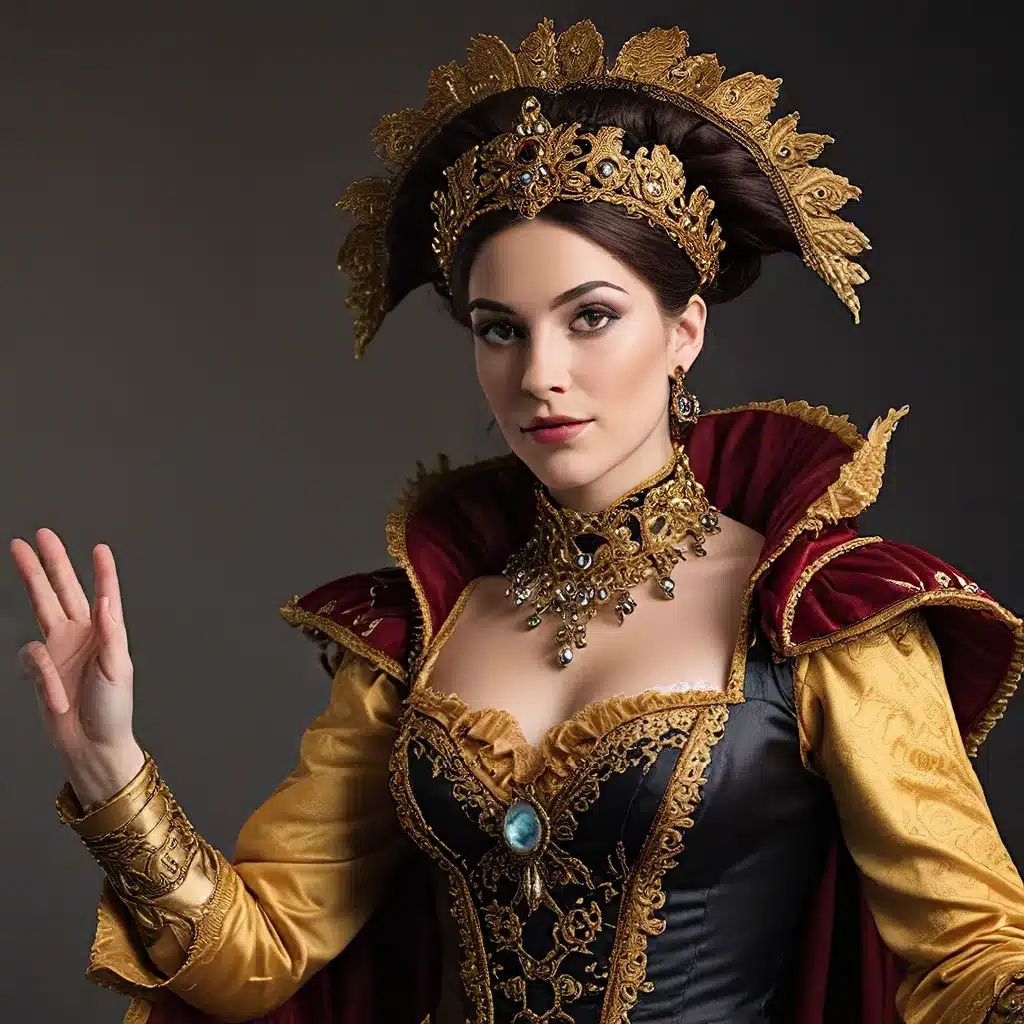
The Transformative Power of Costume
As a lifelong lover of musical theater, I’ve always been fascinated by the power of costume to elevate a performer’s presence on stage. It’s not just about looking the part – a well-crafted costume can be a transformative tool, allowing the actor to fully inhabit their character and connect with the audience in a way that transcends the physical.
Aligning with the Genre
One of the key aspects of enhancing stage presence through costume is ensuring that the attire aligns with the genre and style of the performance. As Dr. Daniel K. Robinson points out, “the genre of your performance often dictates your stage presence. Upon stepping onto the stage, your audience begins forming judgments before you sing your first note.”
So, for example, if I’m performing in a classic Broadway musical, my costume might be a lavish, period-accurate gown or a dapper three-piece suit. But if I’m in a contemporary rock musical, my outfit might be more edgy and rebellious – think skinny jeans, a leather jacket, and studded accessories. The costume choices set the tone and create an immediate visual connection with the audience, priming them for the emotional journey to come.
The Power of Visual Connection
Beyond genre alignment, costume can also be a powerful tool for establishing visual connection with the audience. As Dr. Robinson notes, “your eyes can invite your audience into a shared moment.” By making direct eye contact and incorporating expressive movements and gestures, the performer can draw the audience in and create a sense of intimacy, even in a large theater.
I remember watching a production of “Hamilton” where the actor playing Alexander Hamilton would lean forward during his soliloquies, his gaze intense and unwavering. It was as if he was speaking directly to each individual in the audience, inviting us to share in his character’s triumphs and struggles. The costume – a tailored period coat and waistcoat – only served to heighten this sense of connection, making Hamilton feel like a living, breathing historical figure rather than just a character on a stage.
Engaging the Audience
But it’s not just about the visual connection – costume can also be a powerful tool for engaging the audience on a deeper level. Dr. Robinson suggests that performers try “greeting their audience either verbally or non-verbally,” and I’ve seen this technique used to great effect in musical theater.
I remember attending a production of “The Rocky Horror Show” where the actors would strut and prance down the aisles, interacting with the audience and drawing them into the subversive, sensual world of the show. Their costumes – fishnet stockings, corsets, and platform heels – were an integral part of this audience engagement, serving as a visual invitation to join in the fun and debauchery.
Embracing Tension and Release
Of course, managing physical tension is also crucial to maintaining a powerful stage presence. As Dr. Robinson advises, “Implement mindfulness exercises to identify and release tension from your body. Visualize stress exiting your body with each exhale during your performance.”
I’ve found that this principle applies not just to the performer’s own body, but to the costume as well. A well-designed costume should allow for freedom of movement and expression, without being overly restrictive or constricting. It’s a delicate balance – the costume should feel like a natural extension of the performer’s body, rather than a burden or a distraction.
The Costume as Metaphorical Armor
And speaking of balance, Dr. Robinson makes a fascinating point about the costume as a metaphorical “performance mode” or “costume” that the performer wears for their audience. “This metaphorical costume isn’t a façade,” he explains, “but an expressive tool.”
In a way, the costume can be seen as a kind of protective armor, shielding the performer from the vulnerability and scrutiny of the stage. But it’s not just a shield – it’s also a tool for self-expression, a way of channeling the performer’s energy and emotions into a cohesive, compelling visual presentation.
The Importance of Vocal Technique
Of course, as Dr. Robinson reminds us, the costume is only one piece of the puzzle when it comes to enhancing a performer’s presence. Robust vocal technique is also essential, serving as the “bedrock” for a memorable performance.
Whether the performer is belting out a powerful rock anthem or delivering a delicate ballad, maintaining proper vocal technique is crucial for connecting with the audience and conveying the emotional weight of the material. And just as the costume should feel like a natural extension of the performer’s body, the vocal technique should feel effortless and organic, flowing seamlessly with the character and the story.
Bringing It All Together
As I’ve discovered through my own journey as a performer, the power of costume to enhance stage presence is truly awe-inspiring. When all the elements come together – genre-appropriate attire, powerful visual connection, engaging audience interaction, and impeccable vocal technique – the result is a truly transcendent performance that leaves a lasting impression on the audience.
And that, my friends, is the magic of musical theater. It’s not just about the songs and the stories – it’s about the complete package, the seamless fusion of all the elements that come together to create a truly unforgettable experience.
So, if you’re a performer looking to take your stage presence to the next level, I encourage you to embrace the transformative power of costume. Experiment with different styles and silhouettes, play with the interplay of tension and release, and most importantly, let the costume be a tool for self-expression and connection with your audience.
Who knows – you just might find that the perfect costume is the key to unlocking your full potential as a performer. And that, my friends, is a power worth harnessing.

